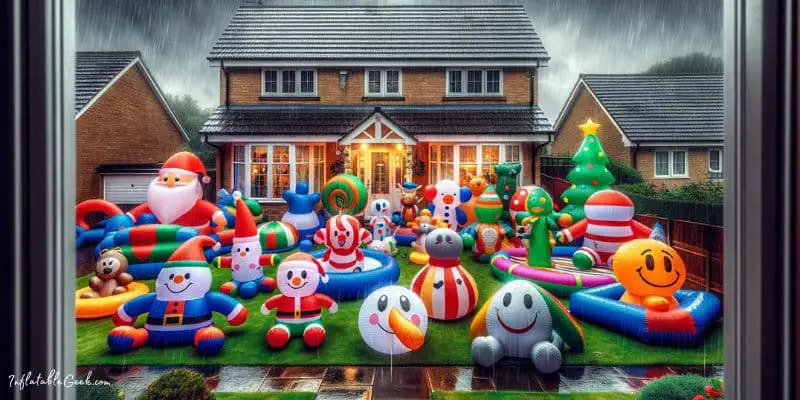Outdoor inflatables have become a staple of holiday decorations, parties, and various outdoor events.
Their durability, ease of setup, and eye-catching designs make them an attractive choice. A common question that arises is about their resilience to various weather conditions, particularly their waterproof capabilities.
So, are outdoor inflatables waterproof?
Yes, Outdoor Inflatables Are Waterproof (Here’s Why)
Outdoor inflatables are designed to be waterproof. They are primarily made from materials such as PVC or nylon, which are inherently resistant to water. These materials can withstand exposure to moisture without absorbing it, preventing damage and mold growth.
(This post may have affiliate links. Please see my disclosure)

Manufacturers understand that outdoor inflatables are likely to be used in a variety of weather conditions and, as such, construct these items with water resistance in mind.
The seams of these inflatables are often sealed or stitched in a way that minimizes water penetration.
Also, the external surfaces are treated with protective coatings to enhance their waterproof qualities.
This combination of material selection and construction techniques ensures that outdoor inflatables can remain outside for extended periods without suffering water damage.
Are Outdoor Inflatables Waterproof in Heavy Rain?
When it comes to heavy rain, outdoor inflatables stand up remarkably well.
Their waterproof materials and construction prevent rainwater from seeping in, ensuring that they remain functional and intact even during downpours.
However, it’s crucial to note that while the inflatables themselves can resist water, their electrical components, such as fans and lights, are usually housed in protective casings but still require caution.
Manufacturers recommend placing these components in areas where they are less likely to be exposed to direct water flow.
Despite their resilience, I suggest that you deflate and store inflatables during extreme weather conditions.
This will only extend their lifespan and maintain safety.
Are Outdoor Inflatables Waterproof in Freezing Temperatures?
Yes, the waterproof nature of outdoor inflatables extends to freezing temperatures as well.
The materials used in their construction do not freeze or crack easily, ensuring that inflatables can withstand cold weather.
However, the issue in freezing temperatures is not the snow or ice per se but the possibility of water getting into small crevices or the inflation mechanism, freezing, and causing physical damage.
To mitigate this risk, be sure that your inflatables are fully dried before being stored.
Also, to check for any signs of damage that could be exacerbated by freezing conditions.
Regular maintenance and careful handling during cold weather can help preserve the integrity of outdoor inflatables, keeping them vibrant and functional season after season.
Are Outdoor Inflatables Waterproof in Standing Water?
While outdoor inflatables are waterproof, prolonged exposure to standing water can pose challenges.
Standing water can lead to issues such as mold and mildew growth on the surface of the inflatable if not properly managed.
Although the materials themselves do not absorb water, standing water can seep into small openings or under the inflatable, creating a damp environment conducive to mold growth.
Place inflatables in well-drained areas or to elevate them slightly off the ground to prevent water from pooling underneath.
If an inflatable does come into contact with standing water, it should be dried off as soon as possible to prevent any long-term damage.
Waterproof Ratings Explained for Inflatables
Understanding waterproof ratings, such as IP (Ingress Protection) codes, can provide valuable insight into the expected performance of outdoor inflatables in various weather conditions.
These ratings basically tell you how good a product is at keeping stuff like dirt and water out.
Not all outdoor inflatables themselves might not come with an IP rating.
However, the electrical components used for inflation and lighting often do.
For example, an IP rating of IP65 indicates that the electrical component is dust-tight and protected against jets of water, making it suitable for outdoor use.
Knowing the IP rating of the electrical components can help consumers gauge how well an inflatable will perform in wet conditions.
Better yet, you’ll make more informed decisions when purchasing outdoor decorations.
Tips for Caring for Your Outdoor Inflatables
Proper care and maintenance can significantly extend the life of your outdoor inflatables, making sure that they remain a festive part of your outdoor decor for years to come.
Here are some tips:
- Regular Inspection – Check for any tears or leaks and repair them promptly to prevent water from entering.
- Proper Storage – Deflate your inflatable completely and ensure it’s dry before folding and storing it in a cool, dry place.
- Avoid Sharp Objects – When setting up, choose a location away from sharp branches or rough surfaces that could puncture the material.
- Use Ground Stakes – Secure your inflatable to prevent it from blowing away or collapsing, which could expose electrical components to water.
- Clean Regularly – Wipe down your inflatable with a damp cloth to remove dirt and debris, which can lead to mildew if left unchecked.
You can also watch this video about how to protect your inflatables from the rain:
Impact of UV Exposure on Waterproofing
Prolonged exposure to sunlight can significantly affect the waterproofing capabilities of outdoor inflatables.
The materials commonly used in their manufacture, such as PVC and nylon, are susceptible to UV radiation, which can lead to material degradation over time.
This degradation isn’t just cosmetic.
It can weaken the fabric’s integrity, making it more prone to tears and leaks, and can compromise the sealants used to keep water out.
To mitigate these effects, owners can use UV protective sprays specifically designed for synthetic fabrics.
These sprays add a protective layer that absorbs or reflects UV rays, prolonging the life of the inflatable.
When possible, it’s advisable to limit the amount of time these decorations are exposed to direct sunlight by setting them up in shaded areas or only during times of the day when UV intensity is lower.
Effectiveness of Waterproof Sprays on Outdoor Inflatables
Applying waterproof sprays can be an effective way to enhance the water resistance of outdoor inflatables.
These sprays work by creating a water-repellent layer on the surface of the inflatable, which helps to prevent water from penetrating the material.
It’s important to choose a spray that is compatible with the material of your inflatable, as some sprays are better suited for nylon, while others are designed for use on PVC.
Before applying, ensure the inflatable is clean and dry.
Apply the spray evenly, following the manufacturer’s instructions, and allow it to dry completely.
While waterproof sprays can offer an additional layer of protection, they are not a permanent solution and should be reapplied periodically, especially after the inflatable has been exposed to heavy rain or cleaned.
FAQ Section
I tried to list and answer every other question you might have about outdoor inflatables and waterproofing.
Can I use outdoor inflatables near a pool or sprinkler system?
Yes, outdoor inflatables are designed to be water-resistant and can be safely used near pools or sprinkler systems.
Just make sure the electrical components are kept dry and at a safe distance from direct water contact to avoid any safety hazards.
Can wind affect the waterproofing of outdoor inflatables?
Wind itself doesn’t directly affect waterproofing but can cause inflatables to rub against rough surfaces or sharp objects, potentially creating tears.
To prevent this, securely anchor your inflatables and place them away from any hazards that could compromise their integrity.
Such as during strong winds.
How can I repair water damage on an outdoor inflatable?
Small punctures or tears can often be repaired with a patch kit designed for the material of your inflatable.
Double check that the area is dry and clean before applying the patch according to the manufacturer’s instructions.
For significant water damage, consulting with a professional repair service is advisable.
What’s the best way to quickly dry an outdoor inflatable?
After deflating, gently pat down the inflatable with towels to remove excess water.
Then, inflate it and allow it to air dry completely in a well-ventilated, shaded area to prevent mildew growth.
Avoid direct sunlight to prevent UV damage during the drying process.
How can I check for water resistance before buying an outdoor inflatable?
Look for product descriptions that specify the materials used and any waterproofing measures, such as sealed seams or UV protective coatings.
Reviews from other buyers can also provide insight into how well the inflatable holds up in wet conditions.
Does the warranty cover water damage on outdoor inflatables?
Warranty coverage varies by manufacturer.
Some may cover water damage if it’s due to a defect in materials or workmanship, while others may not.
Always check the warranty terms before purchasing to understand what is and isn’t covered.
Final Thoughts: Are Outdoor Inflatables Waterproof?
Rain or shine, your cheerful inflatables are ready to party.
We have so many more articles about inflatables so please check some of them out before you go.
Read This Next:

